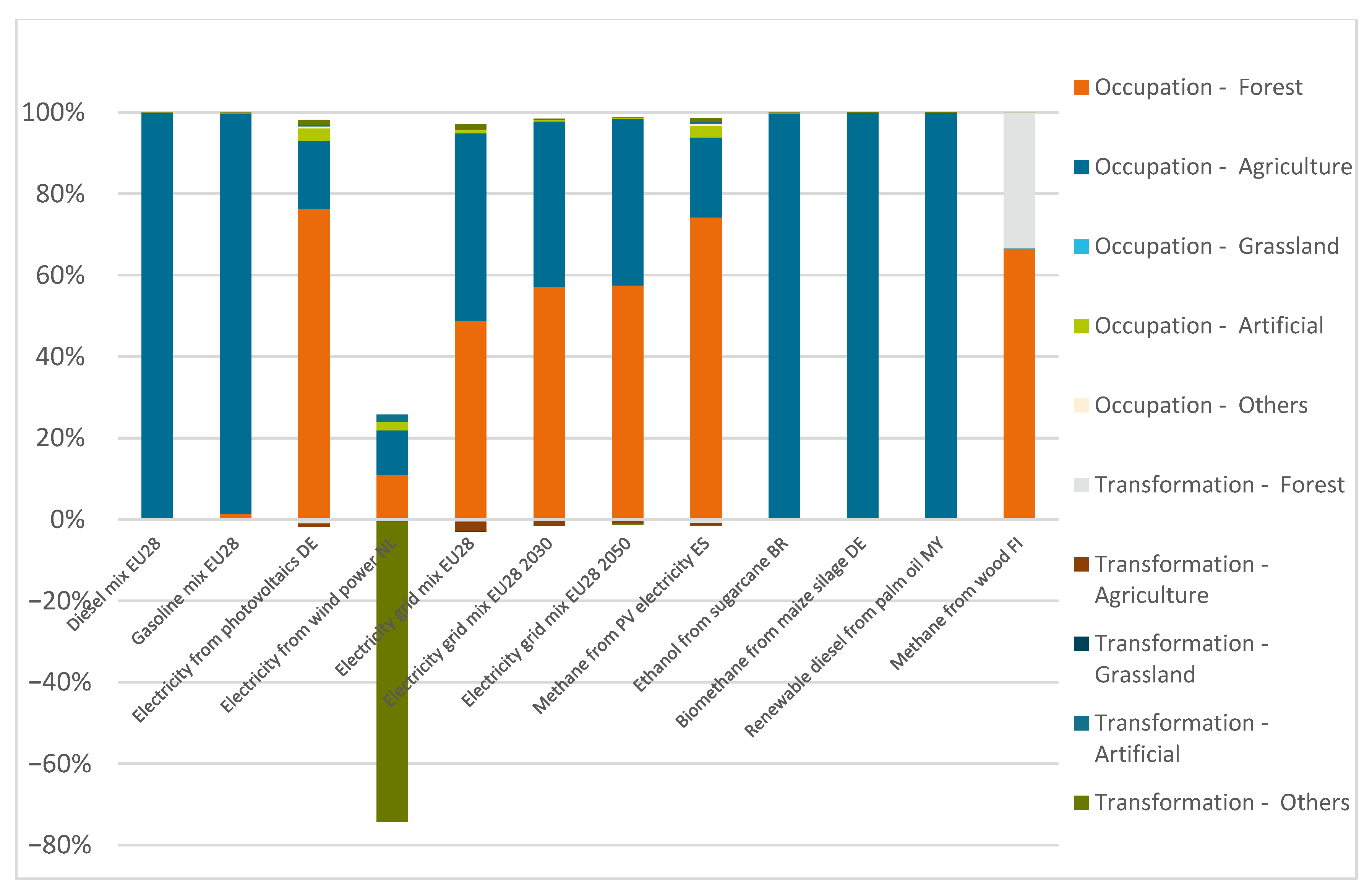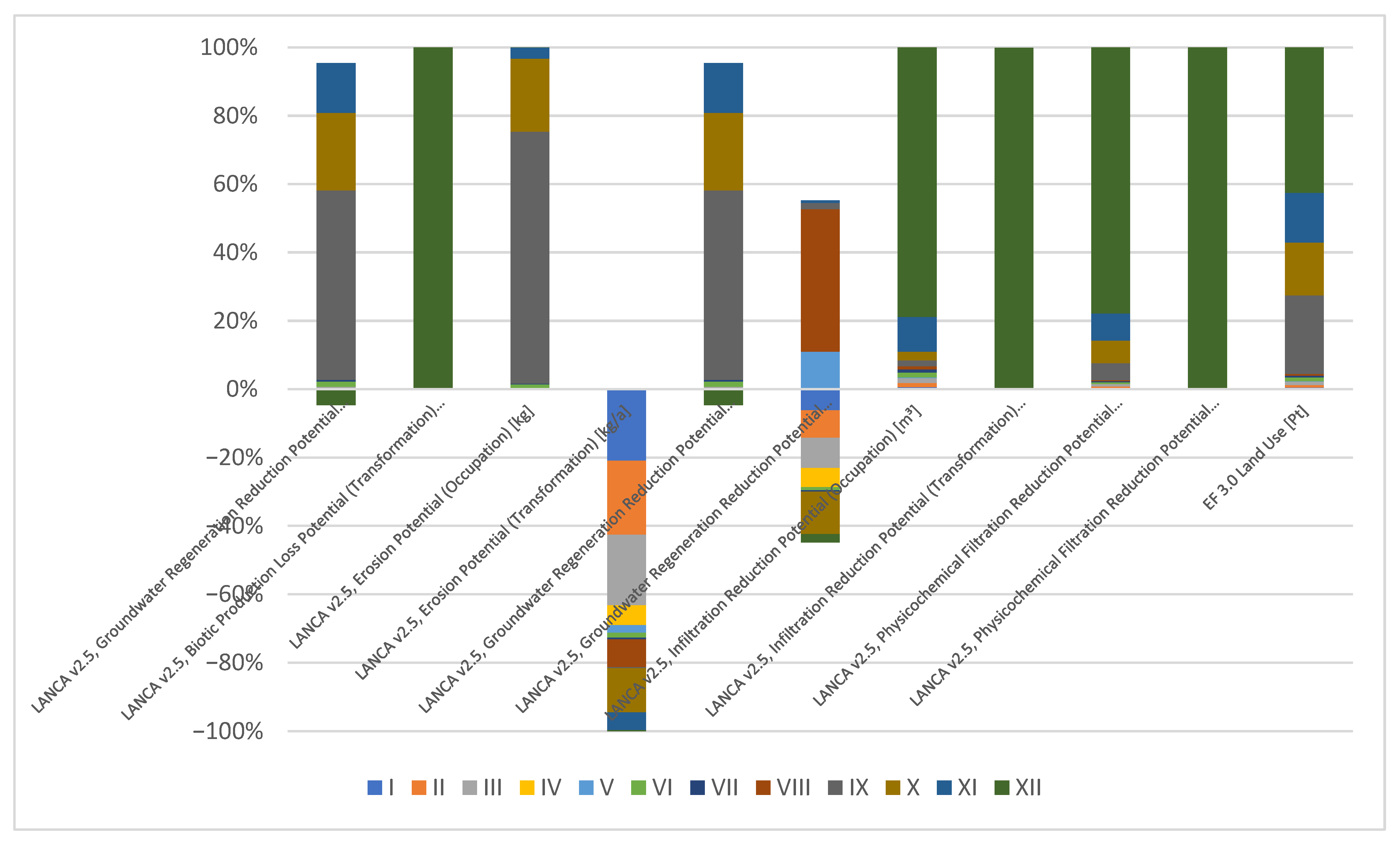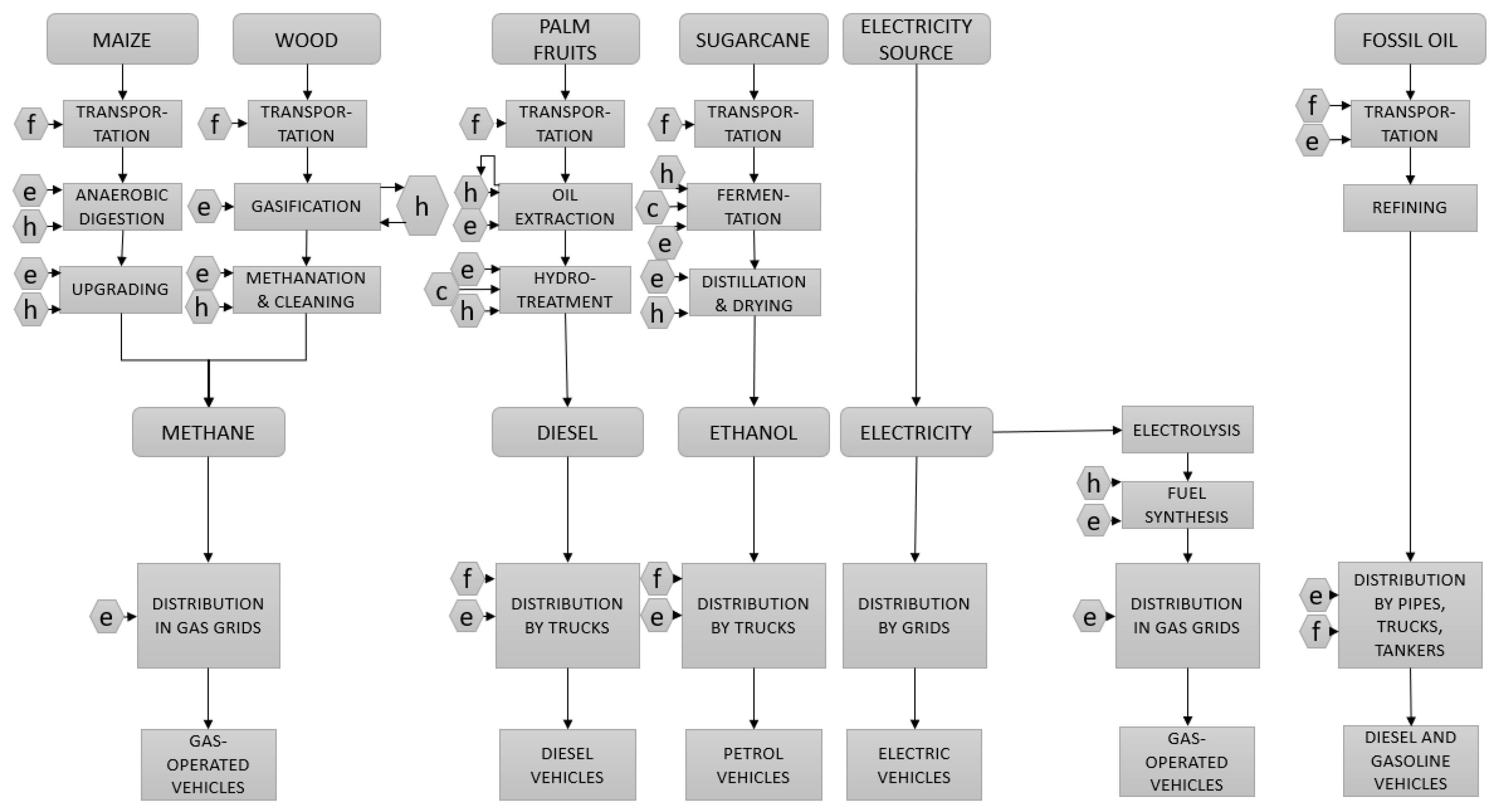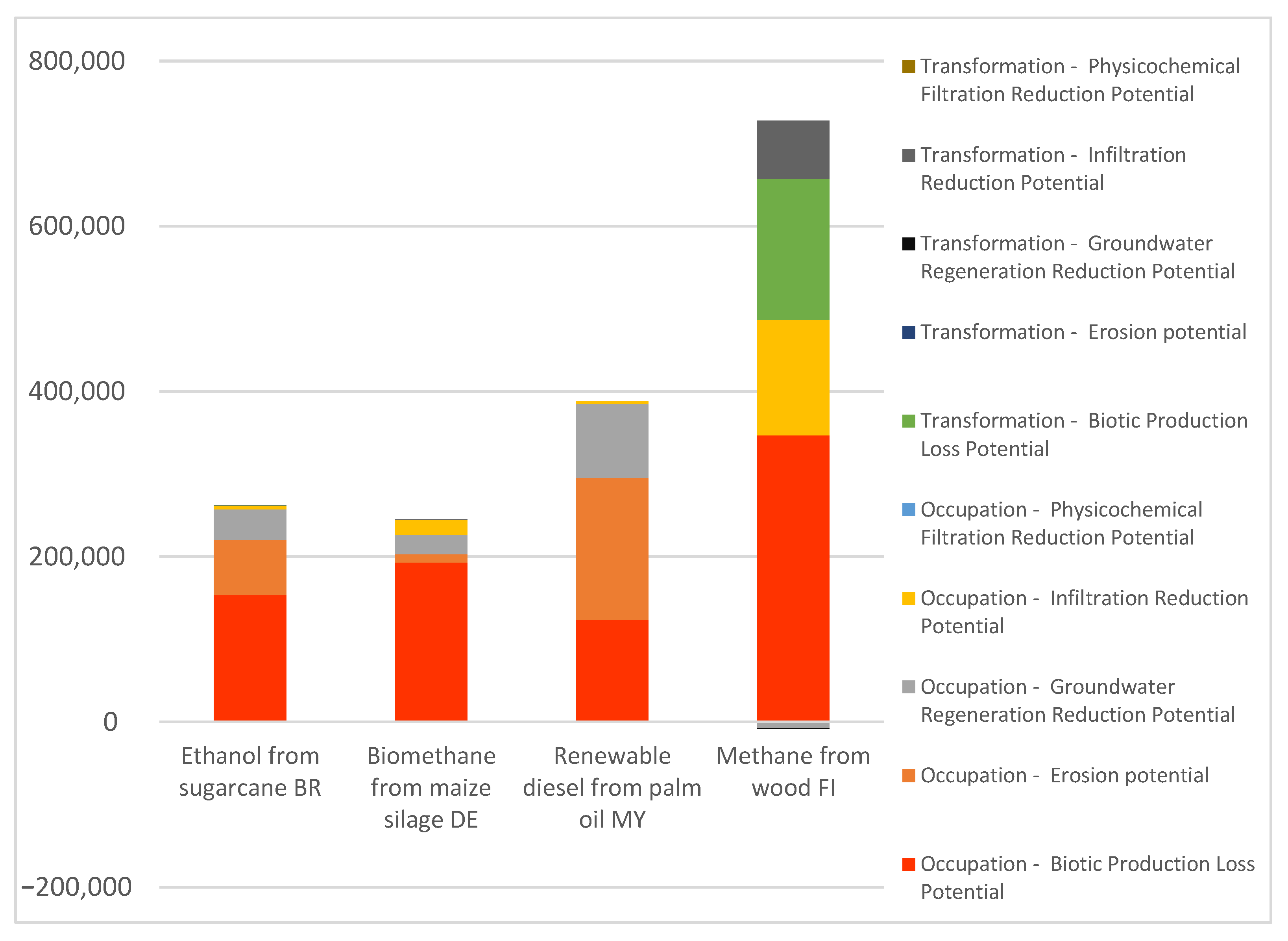Assessing Land Use Efficiencies and Land Quality Impacts of Renewable Transportation Energy Systems for Passenger Cars Using the LANCA® Method
Abstract
:1. Introduction
2. Materials and Methods
2.1. Life Cycle Assessment Methodology for the LANCA® Model
2.2. Selected Pathways for Transportation Energy Production
2.2.1. Tank-to-Wheel Efficiencies of Passenger Cars
2.2.2. Refueling Stations
2.2.3. Allocation
3. Results
4. Discussion
5. Conclusions
Author Contributions
Funding
Institutional Review Board Statement
Informed Consent Statement
Data Availability Statement
Conflicts of Interest
Appendix A
| Life Cycle Phase | Land Occupation (m2a) | Allocation Period for Transformation(a) | Land Transformation from(m2) | Land Transformation to(m2) |
| Electric car charging (per FU) | 0.033 Urban (regionalized, DE) | 20 | 0.00165 (20 a) From urban, green areas (regionalized, DE) | 0.00165 (20 a) To industrial area (regionalized, DE) |
| Petrol/diesel refueling station (per FU) | 0.28 Urban (regionalized, DE) | 20 | No transformation | No transformation |
| Biomethane refueling station (per FU) | 0.28 Urban (regionalized, DE) | 20 | 0.0141 (20 a) From urban, green areas (regionalized, DE) | 0.0141 (20 a) To urban (regionalized, DE) |
| Palm oil extraction (per 1 kg palm oil) | 2.5 × 10−5 Industrial area (regionalized, MY) | 20 | 1.25 × 10−6 (20 a) From forest, natural (regionalized, MY) | 1.25 × 10−6 (20 a) To industrial area (regionalized, MY) |
| HVO process (per 1 kg renewable diesel) | 0.00008 Industrial area (regionalized, NL) | 20 | No land transformation. Build on previous sea | 0.000004 (20 a) To urban (regionalized, NL) |
| SNG production from wood (per FU) | 0.0184 Industrial area (regionalized, FI) | 20 | 0.0009 From forest, intensive (regionalized, FI) | 0.0009 To industrial area (regionalized, FI) |
| Forest use for SNG wood production | 28,000 Forest, intensive (regionalized, FI) | 20 | 1400 From forest natural (regionalized, FI) | 1400 To forest intensive (regionalized, FI) |
| Methanation process (per 1 kg methane) | 2.3 × 10−5 Industrial area (regionalized, ES) | 20 | 1.15 × 10−6 From shrub land (regionalized, ES) | 1.15 × 10−6 To industrial area (regionalized, ES) |
Appendix B


References
- IPCC. Global Warming of a 1.5 °C; IPCC: Geneva Switzerland, 2018. [Google Scholar]
- IPCC. Summary for Policy MakersSummary for Policy Makers; IPCC: Geneva Switzerland, 2014. [Google Scholar]
- U.S. Energy Information Administration. Internation Energy Outlook 2016; U.S. Energy Information Administration: Washington, WA, USA, 2016.
- Richie, H. Sector by Sector: Where Do Global Greenhouse Gas Emissions Come From? Available online: https://ourworldindata.org/ghg-emissions-by-sector (accessed on 21 April 2022).
- REN21. Renewables 2021 Global Status Report; REN21 Secretariat: Paris, France, 2021. [Google Scholar]
- Rockström, J.; Steffen, W.; Noone, K.; Persson, Å.; Chapin, F.S.; Lambin, E.F.; Lenton, T.M.; Scheffer, M.; Folke, C.; Schellnhuber, H.J.; et al. A Safe Operating Space for Humanity. Nature 2009, 461, 472–475. [Google Scholar] [CrossRef] [PubMed]
- Steffen, W.; Richardson, K.; Rockström, J.; Cornell, S.E.; Fetzer, I.; Bennett, E.M.; Biggs, R.; Carpenter, S.R.; De Vries, W.; De Wit, C.A.; et al. Planetary Boundaries: Guiding Human Development on a Changing Planet. Science 2015, 347, 1259855. [Google Scholar] [CrossRef] [PubMed] [Green Version]
- Tilman, D.; Fargione, J.; Wolff, B.; D’Antonio, C.; Dobson, A.; Howarth, R.; Schindler, D.; Schlesinger, W.H.; Simberloff, D.; Swackhamer, D. Forecasting Agriculturally Driven Global Environmental Change. Science 2001, 292, 281–284. [Google Scholar] [CrossRef] [PubMed] [Green Version]
- IPBES. Summary for Policymakers of the Global Assessment Report on Biodiversity and Ecosystem Services of the Intergovernmental Science-Policy Platform on Biodiversity and Ecosystem Services; IPBES: Bonn, Germany, 2019. [Google Scholar]
- Foley, J.A.; Ramankutty, N.; Brauman, K.A.; Cassidy, E.S.; Gerber, J.S.; Johnston, M.; Mueller, N.D.; O’Connell, C.; Ray, D.K.; West, P.C.; et al. Solutions for a Cultivated Planet. Nature 2011, 478, 337–342. [Google Scholar] [CrossRef] [PubMed] [Green Version]
- Metzger, M.J.; Rounsevell, M.D.A.; Acosta-Michlik, L.; Leemans, R.; Schröter, D. The Vulnerability of Ecosystem Services to Land Use Change. Agric. Ecosyst. Environ. 2006, 114, 69–85. [Google Scholar] [CrossRef]
- Foley, J.A.; DeFries, R.; Asner, G.P.; Barford, C.; Bonan, G.; Carpenter, S.R.; Chapin, F.S.; Coe, M.T.; Daily, G.C.; Gibbs, H.K.; et al. Global Consequences of Land Use. Science 2005, 309, 570–574. [Google Scholar] [CrossRef] [Green Version]
- Harvey, L.D.D. Resource Implications of Alternative Strategies for Achieving Zero Greenhouse Gas Emissions from Light-Duty Vehicles by 2060. Appl. Energy 2018, 212, 663–679. [Google Scholar] [CrossRef]
- Uusitalo, V.; Leino, M.; Kasurinen, H.; Linnanen, L. Transportation Biofuel Efficiencies from Cultivated Feedstock in the Boreal Climate Zone: Case Finland. Biomass Bioenergy 2017, 99, 79–89. [Google Scholar] [CrossRef]
- Uusitalo, V.; Leino, M.; Claudelin, A.; Sillman, J. Comparison of Land Use Efficiencies of Different Transportation Energy Systems. In Proceedings of the The 24th International Sustainable Development Research Society Conference: Actions for Sustainable World: From Theory to Practice, Messina, Italy, 13–15 June 2018. [Google Scholar]
- O’Malley, J.; Pavlenko, N.; Stephanie, S. Estimating Sustainable Aviation Fuel Feedstock Availability to Meet Growing European Union Demand; International Council on Clean Transportation: San Francisco, CA, USA, 2021. [Google Scholar]
- Groom, M.J.; Gray, E.M.; Townsend, P.A. Biofuels and Biodiversity: Principles for Creating Better Policies for Biofuel Production. Conserv. Biol. 2008, 22, 602–609. [Google Scholar] [CrossRef]
- Milà i Canals, L.; Romanyà, J.; Cowell, S.J. Method for Assessing Impacts on Life Support Functions (LSF) Related to the Use of ‘Fertile Land’ in Life Cycle Assessment (LCA). J. Clean. Prod. 2007, 15, 1426–1440. [Google Scholar] [CrossRef]
- IPBES. The IPBES Assessment Report on Land Degradation and Restoration; IPBES: Bonn, Germany, 2018. [Google Scholar]
- Souza, D.M.; Teixeira, R.F.M.; Ostermann, O.P. Assessing Biodiversity Loss Due to Land Use with Life Cycle Assessment: Are We There Yet? Glob. Chang. Biol. 2015, 21, 32–47. [Google Scholar] [CrossRef] [PubMed] [Green Version]
- Winter, L.; Lehmann, A.; Finogenova, N.; Finkbeiner, M. Including Biodiversity in Life Cycle Assessment—State of the Art, Gaps and Research Needs. Environ. Impact Assess. Rev. 2017, 67, 88–100. [Google Scholar] [CrossRef]
- Vidal Legaz, B.; Maia De Souza, D.; Teixeira, R.F.M.; Antón, A.; Putman, B.; Sala, S. Soil Quality, Properties, and Functions in Life Cycle Assessment: An Evaluation of Models. J. Clean. Prod. 2017, 140, 502–515. [Google Scholar] [CrossRef]
- Maier, S.D.; Lindner, J.P.; Francisco, J. Conceptual Framework for Biodiversity Assessments in Global Value Chains. Sustainability 2019, 11, 1841. [Google Scholar] [CrossRef] [Green Version]
- Halleux, H.; Lassaux, S.; Renzoni, R.; Germain, A. Comparative Life Cycle Assessment of Two Biofuels: Ethanol from Sugar Beet and Rapeseed Methyl Ester. Int. J. Life Cycle Assess. 2008, 13, 184–190. [Google Scholar] [CrossRef]
- De Laurentiis, V.; Secchi, M.; Bos, U.; Horn, R.; Laurent, A.; Sala, S. Soil Quality Index: Exploring Options for a Comprehensive Assessment of Land Use Impacts in LCA. J. Clean. Prod. 2019, 215, 63–74. [Google Scholar] [CrossRef]
- Beck, T.; Bos, U.; Wittstock, B.; Baitz, M.; Fischer, M.; Sedlbauer, K. LANCA®. Land Use Indicator Value Calculation in Life Cycle Assessment; Publications Office of the European Union: Luxembourg, 2010. [Google Scholar]
- Bos, U.; Horn, R.; Beck, T.; Lindner, J.P.; Fischer, M. LANCA® Characterization Factors for Life Cycle Impact Assessment. Version 2.0; Fraunhofer: Stuttgart, Germany, 2016. [Google Scholar]
- Horn, R.; Maier, S.D. LANCA®—Characterization Factors for Life Cycle Impact Assessment: Version 2.5; Fraunhofer: Stuttgart, Germany, 2018. [Google Scholar]
- European Commissions. Statistical Pocketbook, EU Transport in Figures; European Commissions: Brussels, Belgium, 2018. [Google Scholar]
- ISO 14040; Environmental Management–Life Cycle Assessment—Principles and Framework. International Organization of Standardization: Geneva Switzerland, 2006.
- ISO 14044; Environmental Management–Life Cycle Assessment—Requirements and Guidelines. International Organization of Standardization: Geneva Switzerland, 2006.
- Koellner, T.; de Baan, L.; Beck, T.; Brandão, M.; Civit, B.; Margni, M.; i Canals, L.M.; Saad, R.; de Souza, D.M.; Müller-Wenk, R. UNEP-SETAC Guideline on Global Land Use Impact Assessment on Biodiversity and Ecosystem Services in LCA. Int. J. Life Cycle Assess. 2013, 18, 1188–1202. [Google Scholar] [CrossRef] [Green Version]
- International Organization of Motor Vehicle Manufacturers. Motorization Rate 2015 Worldwide. Available online: http://www.oica.net/category/vehicles-in-use/ (accessed on 15 November 2019).
- International Energy Agency Renewables. Market Analysis and Forecast from 2018 to 2023. 2018. Available online: https://www.iea.org/renewables2018/transport/ (accessed on 15 November 2019).
- Schmidt, P.; Zittel, W.; Weindorf, W.; Rakasha, T.; Goericke, D. Renewables in Transport 2050—Empowering a Sustainable Mobility Future with Zero Emission Fuels. In 16. Internationales Stuttgarter Symposium; Springer: Wiesbaden, Germany, 2016; pp. 185–199. [Google Scholar]
- International Energy Agency. Global EV Outlook 2018, towards Cross-Modal Electrification; International Energy Agency: Paris, France, 2018. [Google Scholar]
- Schemme, S.; Samsun, R.C.; Peters, R.; Stolten, D. Power-to-Fuel as a Key to Sustainable Transport Systems—An Analysis of Diesel Fuels Produced from CO2 and Renewable Electricity. Fuel 2017, 205, 198–221. [Google Scholar] [CrossRef]
- Uusitalo, V.; Väisänen, S.; Inkeri, E.; Soukka, R. Potential for Greenhouse Gas Emission Reductions Using Surplus Electricity in Hydrogen, Methane and Methanol Production via Electrolysis. Energy Convers. Manag. 2017, 134, 125–134. [Google Scholar] [CrossRef]
- World Atlas Top Palm Oil Producing Countries in the World. Available online: https://www.worldatlas.com/articles/top-palm-oil-producing-countries-in-the-world.html (accessed on 11 November 2019).
- Harsono, S.S.; Prochnow, A.; Grundmann, P.; Hansen, A.; Hallmann, C. Energy Balances and Greenhouse Gas Emissions of Palm Oil Biodiesel in Indonesia. GCB Bioenergy 2012, 4, 213–228. [Google Scholar] [CrossRef]
- Uusitalo, V.; Väisänen, S.; Havukainen, J.; Havukainen, M.; Soukka, R.; Luoranen, M. Carbon Footprint of Renewable Diesel from Palm Oil, Jatropha Oil and Rapeseed Oil. Renew. Energy 2014, 69, 103–113. [Google Scholar] [CrossRef]
- Neste Rotterdam Refinery. Available online: https://www.neste.com/corporate-info/who-we-are/production/rotterdam-refinery (accessed on 24 February 2021).
- Uusitalo, V.; Havukainen, J.; Kapustina, V.; Soukka, R.; Horttanainen, M. Greenhouse Gas Emissions of Biomethane for Transport: Uncertainties and Allocation Methods. Energy Fuels 2014, 28, 1901–1910. [Google Scholar] [CrossRef]
- Global Forest Atlas Boreal Zone; Food and Agriculture Organization of the United Nations: Rome, Italy.
- Natural Resources Institute Finland Most Recent Information about Forest Resources in Luke’s Statistical Portal. Available online: https://www.luke.fi/en/news/most-recent-information-about-forest-resources-in-lukes-statistics-portal/ (accessed on 4 November 2019).
- Leino, M.; Uusitalo, V.; Grönman, A.; Nerg, J.; Horttanainen, M.; Soukka, R.; Pyrhönen, J. Economics and Greenhouse Gas Balance of Distributed Electricity Production at Sawmills Using Hermetic Turbogenerator. Renew. Energy 2016, 88, 102–111. [Google Scholar] [CrossRef]
- Göteborg Energi Gothenburg Biomass Gasification Project, GoBiGas; City of Gothenburg: Gothenburg, Sweden, 2015.
- Steubing, B.; Reinhard, J. LCA of the Production of Synthetic Natural Gas from Wood and Consideration to the Optimal Plant Scale. Available online: http://www.lcaforum.ch/portals/0/df36/DF36-3BernhardSteubing.pdf (accessed on 2 November 2019).
- Siitonen, S. Benefits and Challenges of Bio-SNG Production. Available online: https://www.vtt.fi/files/projects/vetaani/sari_siitonen.pdf (accessed on 2 November 2019).
- Global Solar Atlas. Available online: https://globalsolaratlas.info/ (accessed on 5 December 2020).
- Green, M.A.; Dunlop, E.D.; Levi, D.H.; Hohl-Ebinger, J.; Yoshita, M.; Ho-Baillie, A.W.Y. Solar Cell Efficiency Tables (Version 54). Prog. Photovolt. Res. Appl. 2019, 27, 565–575. [Google Scholar] [CrossRef]
- Global Wind Atlas Global Wind Atlas. Available online: https://globalwindatlas.info/ (accessed on 5 December 2020).
- Schriimeister, S.; von Morstein, O.; Föcker, H. Demonstration Plant Falkenhagen Commissioned/Commissioning Report; European Commission: Brussels, Belgium, 2017. [Google Scholar]
- Technical Research Centre Finland Lipasto Unit Emissions Database. Available online: http://lipasto.vtt.fi/yksikkopaastot/indexe.htm (accessed on 10 November 2020).
- Lask, J.; Wagner, M.; Trindade, L.M.; Lewandowski, I. Life Cycle Assessment of Ethanol Production from Miscanthus: A Comparison of Production Pathways at Two European Sites. GCB Bioenergy 2019, 11, 269–288. [Google Scholar] [CrossRef] [Green Version]
- Fuels Europe. Number of Petrol Stations in Europe. Available online: www.fuelseurope.eu (accessed on 15 November 2020).
- Engel, H.; Hensley, R.; Knupfer, S.; Sahdev, S. Charging Ahead: Elecric Vehicle Infrastructure Demand. Available online: https://www.mckinsey.com/industries/automotive-and-assembly/our-insights/charging-ahead-electric-vehicle-infrastructure-demand# (accessed on 15 November 2020).
- European Commission. Directive (EU) 2018/2001 of the European Parliament and of the Council, on the Promotion of the Use of Energy from Renewable Resources; European Commission: Brussels, Belgium, 2018. [Google Scholar]
- Bos, U. Operationalisierung und Charakterisierung der Flächeninanspruchnahme im Rahmen der Ökobilanz; Fraunhofer: Stuttgart, Germany, 2019. [Google Scholar]
- Bos, U.; Maier, S.D.; Horn, R.; Leistner, P.; Finkbeiner, M. A GIS Based Method to Calculate Regionalized Land Use Characterization Factors for Life Cycle Impact Assessment Using LANCA®. Int. J. Life Cycle Assess. 2020, 25, 1259–1277. [Google Scholar] [CrossRef]
- Borrelli, P.; Robinson, D.A.; Fleischer, L.R.; Lugato, E.; Ballabio, C.; Alewell, C.; Meusburger, K.; Modugno, S.; Schütt, B.; Ferro, V.; et al. An Assessment of the Global Impact of 21st Century Land Use Change on Soil Erosion. Nat. Commun. 2017, 8, 2013. [Google Scholar] [CrossRef] [Green Version]
- Terranova, D.; Balugani, E.; Righi, S.; Marazza, D. An Applicability Assessment and Sensitivity Analysis of Land Use Impact Models: Application of the LANCA Model in Site-Specific Conditions. Int. J. Life Cycle Assess. 2021, 26, 2215–2231. [Google Scholar] [CrossRef]
- Thoumazeau, A.; Bustany, C.; Ridrigues, J.; Bessou, C. Using the LANCA® Model to Account for Soil Quality Within LCA: First Application and Approach Comparison in Two Contrasted Tropical Case Studies. IJoLCAS 2019, 3, 1–13. [Google Scholar] [CrossRef]
- Searchinger, T.D.; Wirsenius, S.; Beringer, T.; Dumas, P. Assessing the Efficiency of Changes in Land Use for Mitigating Climate Change. Nature 2018, 564, 249–253. [Google Scholar] [CrossRef]
- Ram, M.; Bogdanov, D.; Aghahosseini, A.; Khalili, S.; Child, M.; Fasihi, M.; Traber, T.; Breyer, C. European Energy System Based on 100% Renewable Energy—Transport Sector BT. In Mobilität der Zukunft: Intermodale Verkehrskonzepte; Siebenpfeiffer, W., Ed.; Springer: Berlin/Heidelberg, Germany, 2021; pp. 519–562. ISBN 978-3-662-61352-8. [Google Scholar]



| Product | Feedstock and/or Production Method | The Main Geographical Location of Production | Geographical Location for the Functional Unit |
|---|---|---|---|
| Fossil fuels | |||
| Diesel | Fossil oil | Diesel mix at filling stations, EU-28 | Central EU |
| Gasoline | Fossil oil | Gasoline mix at filling stations, EU-28 | Central EU |
| Biofuels | |||
| Diesel | Hydrotreatment from palm oil | Southeast Asia, Malaysia | Central EU |
| Ethanol | Sugarcane | South America, Brazil | Central EU |
| Methane | Anaerobic digestion from maize | Production mix for EU-28 | Central EU |
| Methane | Gasification from wood | Northern Europe, Finland | Central EU |
| Electricity | |||
| Wind | North Sea coastlines, Netherlands | Central EU | |
| Solar PV (2) | Central Europe, Germany | Central EU | |
| Grid mix | Production mix for EU-28 | Central EU | |
| Grid mix 2030 | Production mix for EU-28 | Central EU | |
| Grid mix 2050 | Production mix for EU-28 | Central EU | |
| Power-to-fuel | |||
| Methane | Power to methane with DAC (1) | Solar PVs in Spain | Central EU |
| Process Step with Multiple Outputs | Allocation Method | Main Product and Share of Allocation | Co-Products and Share of Allocation |
|---|---|---|---|
| Palm oil extraction | Energy | Vegetable oil (36 MJ kg−1): 80% | Kernel oil (36 MJ kg−1): 20% |
| Renewable diesel production | Energy | Diesel (44 MJ kg−1): 91% | Gasoline (44 MJ kg−1), propane (46 MJ kg−1): 9% |
| Electric car charging | Time | 24 h per year allocated for one car: 0.3% | Annual fast charging station, with charging time of 6552 h periods: 99.7% |
| Diesel Mix EU28 | Gasoline Mix EU28 | Electricity from Photovoltaics DE | Electricity from Wind Power NL | Electricity Grid Mix EU28 | Electricity Grid Mix EU28 2030 | Electricity Grid Mix EU28 2050 | Methane from PV Electricity ES | Ethanol from Sugarcane BR | Biomethane from Maize Silage DE | Renewable Diesel from Palm Oil MY | Methane from Wood FI | |
|---|---|---|---|---|---|---|---|---|---|---|---|---|
| Biotic Production Loss Potential (Occupation) (kg) | 1.71 × 102 | 8.86 × 101 | 2.09 × 101 | 1.23 × 100 | 9.58 × 101 | 1.60 × 102 | 1.94 × 102 | 9.62 × 101 | 2.28 × 103 | 2.87 × 103 | 1.84 × 103 | 5.16 × 103 |
| Biotic Production Loss Potential (Transformation) (kg/a) | 6.62 × 10−3 | 7.50 × 10−3 | 9.87 × 10−4 | −1.08 × 10−1 | 3.42 × 10−3 | −3.28 × 10−2 | −5.02 × 10−2 | −5.59 × 10−3 | 1.43 × 10−1 | 9.37 × 10−3 | 5.43 × 10−3 | 2.54 × 102 |
| Erosion Potential (Occupation) (kg) | 2.55 × 103 | 3.38 × 102 | 4.04 × 101 | 3.71 × 100 | 1.37 × 102 | 1.88 × 102 | 2.24 × 102 | 1.65 × 102 | 4.60 × 104 | 6.95 × 103 | 1.59 × 105 | 1.47 × 102 |
| Erosion Potential (Transformation) (kg/a) | −2.27 × 10−1 | −7.74 × 10−2 | −3.42 × 10−1 | −8.99 × 10−1 | −3.25 × 100 | −3.36 × 100 | −3.20 × 100 | −1.26 × 100 | −2.01 × 100 | −7.77 × 10−1 | −4.82 × 10−2 | −5.59 × 10−2 |
| Groundwater Regeneration Reduction Potential (Occupation) (m³) | 1.15 × 101 | 3.27 × 100 | 8.79 × 10−2 | 3.01 × 10−2 | 1.40 × 100 | 1.81 × 100 | 2.18 × 100 | 4.95 × 10−1 | 1.69 × 102 | 1.08 × 102 | 4.11 × 102 | −3.43 × 101 |
| Groundwater Regeneration Reduction Potential (Transformation) (m³/a) | −9.41 × 10−4 | −4.46 × 10−4 | 1.22 × 10−2 | −6.23 × 10−3 | −6.90 × 10−3 | −8.87 × 10−3 | −9.89 × 10−3 | 4.63 × 10−2 | −1.38 × 10−2 | 7.65 × 10−4 | 2.04 × 10−3 | −2.71 × 10−3 |
| Infiltration Reduction Potential (Occupation) (m³) | 6.62 × 103 | 4.12 × 103 | 9.00 × 102 | 3.66 × 101 | 3.03 × 103 | 5.33 × 103 | 6.45 × 103 | 4.00 × 103 | 1.15 × 104 | 4.64 × 104 | 7.96 × 103 | 3.58 × 105 |
| Infiltration Reduction Potential (Transformation) (m³/a) | −6.76 × 10−2 | 4.55 × 10−1 | −5.76 × 10−1 | 1.37 × 10−1 | −9.52 × 100 | −8.88 × 100 | −7.70 × 100 | 6.32 × 100 | 5.40 × 100 | −9.19 × 10−1 | 1.32 × 10−1 | 1.78 × 104 |
| Physicochemical Filtration Reduction Potential (Occupation) (mol*a) | 2.42 × 103 | 1.31 × 103 | 3.80 × 102 | 2.18 × 101 | 1.57 × 103 | 2.66 × 103 | 3.22 × 103 | 1.75 × 103 | 3.26 × 104 | 3.90 × 104 | 2.47 × 104 | 3.85 × 105 |
| Physicochemical Filtration Reduction Potential (Transformation) (mol) | −8.06 × 10−2 | 1.10 × 10−2 | −1.77 × 10−1 | 1.18 × 10−1 | −4.31 × 100 | −3.80 × 100 | −3.11 × 100 | 6.95 × 10−2 | 1.34 × 100 | 1.12 × 10−1 | 5.33 × 10−1 | 1.92 × 104 |
| EF 3.0 Land Use (Pt) | 1.57 × 105 | 6.97 × 104 | 1.47 × 104 | 1.97 × 102 | 6.39 × 104 | 1.06 × 105 | 1.29 × 105 | 6.73 × 104 | 2.08 × 106 | 1.94 × 106 | 3.08 × 106 | 5.72 × 106 |
Publisher’s Note: MDPI stays neutral with regard to jurisdictional claims in published maps and institutional affiliations. |
© 2022 by the authors. Licensee MDPI, Basel, Switzerland. This article is an open access article distributed under the terms and conditions of the Creative Commons Attribution (CC BY) license (https://creativecommons.org/licenses/by/4.0/).
Share and Cite
Uusitalo, V.; Horn, R.; Maier, S.D. Assessing Land Use Efficiencies and Land Quality Impacts of Renewable Transportation Energy Systems for Passenger Cars Using the LANCA® Method. Sustainability 2022, 14, 6144. https://doi.org/10.3390/su14106144
Uusitalo V, Horn R, Maier SD. Assessing Land Use Efficiencies and Land Quality Impacts of Renewable Transportation Energy Systems for Passenger Cars Using the LANCA® Method. Sustainability. 2022; 14(10):6144. https://doi.org/10.3390/su14106144
Chicago/Turabian StyleUusitalo, Ville, Rafael Horn, and Stephanie D. Maier. 2022. "Assessing Land Use Efficiencies and Land Quality Impacts of Renewable Transportation Energy Systems for Passenger Cars Using the LANCA® Method" Sustainability 14, no. 10: 6144. https://doi.org/10.3390/su14106144
APA StyleUusitalo, V., Horn, R., & Maier, S. D. (2022). Assessing Land Use Efficiencies and Land Quality Impacts of Renewable Transportation Energy Systems for Passenger Cars Using the LANCA® Method. Sustainability, 14(10), 6144. https://doi.org/10.3390/su14106144






